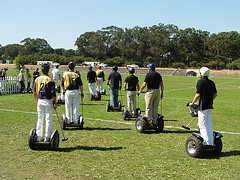 Remember the Segway? Back in 2000, the self-balancing scooter was hyped as the Second Coming of wheeled transport. Unfortunately for its inventor, eccentric New Yorker Dean Kamen, it hasn’t really caught on outside a narrow circle of enthusiasts. But Kamen doesn’t care. He’s got something better:
Remember the Segway? Back in 2000, the self-balancing scooter was hyped as the Second Coming of wheeled transport. Unfortunately for its inventor, eccentric New Yorker Dean Kamen, it hasn’t really caught on outside a narrow circle of enthusiasts. But Kamen doesn’t care. He’s got something better:
Conceived in Scotland almost 200 years ago, the Stirling is a marvel of thermodynamics that could help to replace the internal combustion engine—in theory it can turn any source of heat into electricity, in silence and with 100 percent efficiency. But corporations including Phillips, Ford and Nasa have devoted decades of research, and millions of dollars, to developing the engine, and all retired defeated, having failed to find a way of turning the theoretical principles of the engine into a workable everyday application.
After ten years and a $40 million investment, Kamen and his engineers think they’ve succeeded where NASA failed. Though the Stirlings aren’t ready for commercial use, Kamen says he’s test-driven engines burning everything from jet fuel to cow manure. They don’t work in cars yet, he says. But they will.
Kamen isn’t your typical eco-warrior. On the one hand, he makes his seven-mile daily commute via personal helicopter; on the other, when New York authorities told him he couldn’t put a wind turbine on his private island, he evaded them by declaring it an independent nation (North Dumpling) of which he was sole sovereign (Lord Dumpling).
But Kamen is a tinkerer, and he has plenty of resources to devote to solving the Stirling engine. There’s no guarantee he can do it. But oil doesn’t grow on trees, and a lot of people would like to keep using cars as their primary transportation (just look at all the ways we’re trying to keep them on the road). Whoever invents the first truly green, cost-effective car is going to become a gazillionaire, at least in this country. And if it’s Dean Kamen, don’t be surprised if you and all your friends are driving Dumplings to work.
Photo used under a Creative Commons license from Franco Folini.











